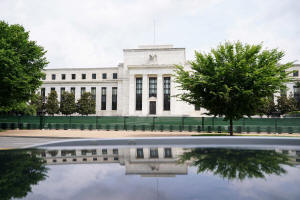Fed seen sticking to interest rate hikes even as unemployment rises
 Send a link to a friend
Send a link to a friend
 [September 03, 2022]
By Ann Saphir [September 03, 2022]
By Ann Saphir
(Reuters) -The Federal Reserve is seen
sticking to sharp interest rate hikes in coming months to cool
inflation, but rising U.S. unemployment and a slowdown in wage growth
has traders betting that borrowing costs next year may not end up quite
as high as previously anticipated.
That's the read from markets after the Labor Department reported Friday
that employers added a more-than-expected 315,000 jobs last month, the
unemployment rate rose to 3.7% from 3.5% as more workers joined the
labor force, and wage growth slowed from its earlier torrid pace.
Traders still expect the Fed to deliver a third 75-basis point rate hike
at its Sept 20-21 meeting, lifting the benchmark rate to 3%-3.25%,
though they have pared that probability to 60% from 70% before the
report, based on the CME Fedwatch tool.
Futures contracts closely linked to the Fed's policy rate for next year
show traders are now pricing in a top Fed funds rate in the bottom of
the 3.75%-4% range by March, down from near the top of that range
earlier.

"The August employment report paints a very positive picture," wrote
James Knightley, chief international economist at ING Economics. "With
wage growth coming in lower than expected it points to a slower pace of
rate hikes after September's expected 75 basis point move."
Fed Chair Jerome Powell a week ago said the Fed will raise borrowing
costs high enough to start biting into growth, soften the labor market
and bring down inflation, but said the size of September's rate hike
would depend on the "totality" of the data before then.
With prices rising at more than three times the Fed's 2% inflation
target and at the highest in 40 years, the jobs report will play second
fiddle to data in coming weeks on consumer prices and inflation
expectations, both key concerns as the Powell Fed seeks to bring demand
down to meet constrained supply.
"The report was a step in the right direction, but it wasn’t a giant
leap in that direction," said Brian Jacobsen, senior investment
strategist, Allspring Global Investments, who saw Friday's job report as
shifting the balance marginally toward a half-point rate hike in
September.
[to top of second column] |

The exterior of the Marriner S. Eccles
Federal Reserve Board Building is seen in Washington, D.C., U.S.,
June 14, 2022. REUTERS/Sarah Silbiger

"The key thing will be of course the inflation data. That will probably seal the
deal as to whether it should be 50 or 75 basis points," he said.
For many Americans, the big question is less about the exact size of September's
rate increases and more about whether those working will be able to keep their
jobs - and for the U.S. economy to skirt recession - as the Fed bears down on
inflation.
"There's been this debate about soft landing versus recession for a while that
economists and investors have been wrestling with," said State Street strategist
Michael Arone. "This job report supports the soft landing narrative."
Still it would take a lot of things to go right to achieve that happy outcome,
most of which is beyond the Fed's control and which historically has little
precedent.
Prices of futures contracts settling next year showed traders now expect the Fed
to lift its policy rate to about 3.83% by March, down from the 3.9% seen before
the jobs report.
The Fed is seen keeping rates in the 3.75%-4% range until after next summer,
when market participants expect the central bank to ease policy slightly.
Fed policymakers have leaned against that scenario, with Cleveland Fed President
Loretta Mester saying she does not expect any rate cuts next year.
The Fed will publish fresh policymaker forecasts in September when it delivers
its next interest-rate decision.
(Reporting by Ann Saphir; Additional reporting by Herbert Lash, Lucia Mutikani,
Carolina Mandl da Silva and Lindsay Dunsmuir; Editing by Andrea Ricci)
[© 2022 Thomson Reuters. All rights
reserved.]This material may not be published,
broadcast, rewritten or redistributed.
Thompson Reuters is solely responsible for this content.
 |